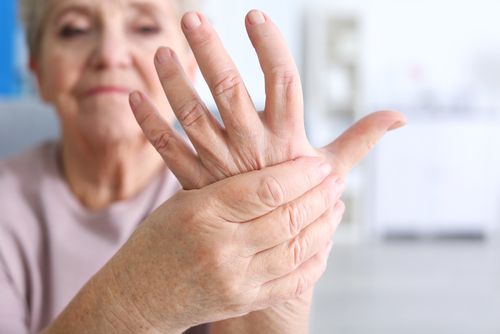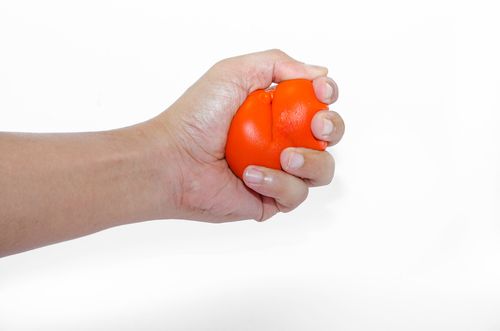 Written by Sara McEvoy, PT, DPT
Written by Sara McEvoy, PT, DPT
Does arthritis affect your hands, fingers, and wrist joints? Do you struggle to type on your cell phone or computer, button a shirt, or handle utensils? Perhaps your function is okay but your quality of life is still negatively affected by stiffness, soreness, and pain in your hand, fingers, thumb, and wrists.
If these concerns sound familiar, understand that you're not alone. An estimated 54 million Americans live with similar symptoms due to arthritis. Arthritis is a broad term used to describe over 100 conditions associated with chronic inflammation and joint damage.
Osteoarthritis, which affects over 30 million Americans, is one of the most common types of arthritis, affecting joints throughout the body, including those in the hand and arm.
While there are many ways to manage pain and other symptoms associated with arthritis, exercise is an essential tool to have in your self-care toolbox. In fact, exercise is considered one of the best ways to relieve arthritic pain.
What types of exercises are helpful for hand, finger, thumb, and wrist pain caused by arthritis? We're happy to share our top recommendations!

Talk to a doctor or physical therapist if you're concerned about arthritis. He or she can confirm a diagnosis and help you get a customized treatment plan started. Seeking earlier treatment may improve your outcomes, so don't hesitate!
Arthritis signs and symptoms which often prompt people to seek medical care include:
In addition to the hands, fingers, and wrists, other areas of the body commonly affected by osteoarthritis include the shoulder, hip, and knee joints.

So, you're worried about arthritis. What can you do to help manage pain and improve your hand mobility?
The following exercises come straight from the rehabilitation world! They're often prescribed by physical therapists, occupational therapists, and other clinicians who provide hand therapy to patients experiencing pain or weakness.
And, the great thing about these exercises is that they require no equipment and can be done in the comfort of your own home. However, if you want to ramp up the effectiveness as you progress, adding simple tools like exercise putty will really take these exercises to the next level.
The main goals of these exercises are to relieve pain, reduce stiffness, improve range of motion, and increase the strength in your hands and wrists. For optimal results, perform each exercise at least 10 times two to three times per day, or as prescribed by your physician or therapist.
Make sure to breathe deeply while you're doing these movements! This will help increase the amount of oxygen sent to your tissues and can also be a great way to manage any pain.
Keep in mind that while these exercises may be challenging, they shouldn't increase in your pain. Perform only the ones that feel the most comfortable for you, stop if you experience worsening symptoms, and talk to your healthcare provider if you have any questions.
Make a fist, allowing your thumb to cross your fingers. Hold for 5-10 seconds, then release and open your hand as fully as possible.
Touch the tip of your thumb against the tip of your pointer finger, then your middle finger, then your ring finger, and finally your pinkie finger. Repeat these sequence at least 10 times. You can also try going in the reverse direction.
Bend your knuckles while keeping your fingers straight. Your hand should be shaped like an L. Then, pull your fingers back and up until your fingertips touch the top of your palm (or as close as you can get them). In this position, your hand looks like a claw. Alternate back and forth from an L-shape to a claw-shape at least 10 times.
Place your hand palm down on a flat surface such as a table or countertop. Gently flatten your fingers and palm against the surface as much as you can—challenge yourself, but don't force your joints into the position! Hold for 10-20 seconds, then relax.
Put some flattened putty or a cold damp washcloth on a stable surface. Using your thumb and pointer fingers, pinch up the material at least 10-20 times.
Hold a tennis ball, ball of socks, or a similar object in your hand. Squeeze the object as hard as you can and hold for 5-10 seconds. Relax your grip, then repeat.
Place your hand palm down on a flat surface. Lift then lower one finger at a time, as high as you can go comfortably. It should look like you're slowly tapping your fingers. When lifting your thumb, try to lift straight up and also straight out to the side.
Hold your hands out in front of you and make gentle fists. Rotate your wrists in a clockwise or counter-clockwise direction for at least 10-20 seconds. Then stop and reverse direction.

Sara McEvoy, PT, DPT, is a licensed and board-certified Doctor of Physical Therapy. She has direct clinical experience within the long-term acute care and skilled nursing settings, and has a special interest in geriatrics and neurological rehab. She is also a freelance writer who creates content almost exclusively within the health and wellness fields.